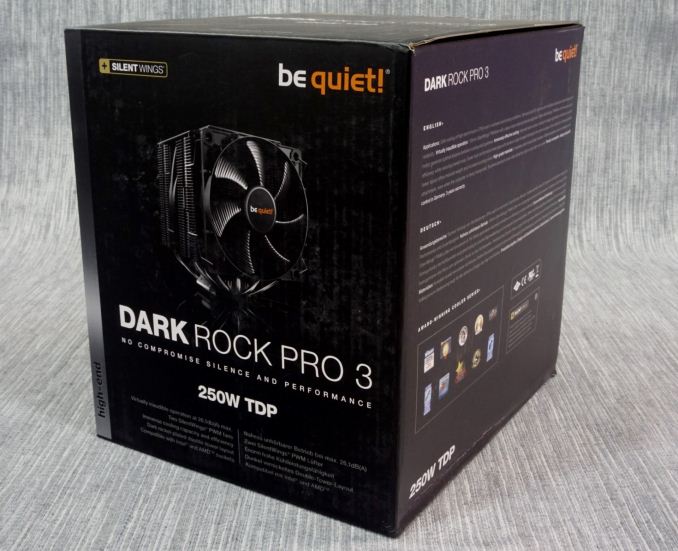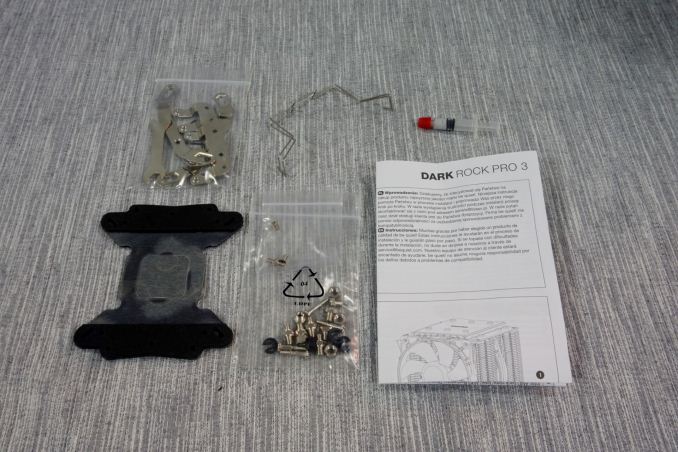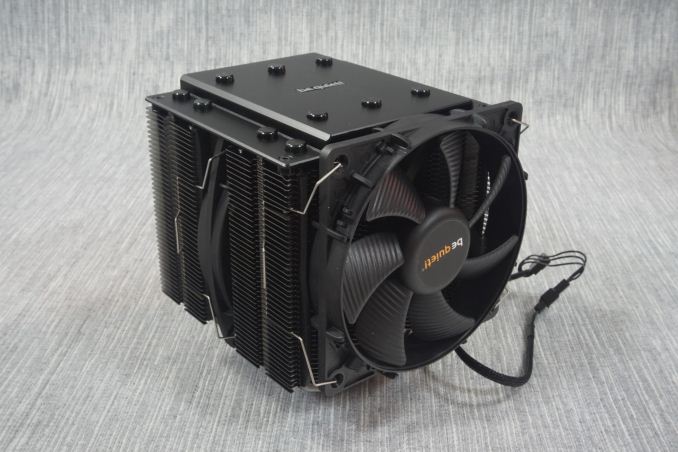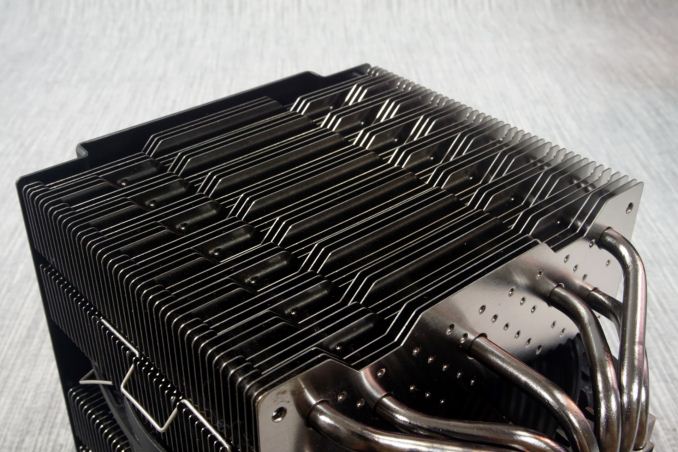Top Tier CPU Air Coolers Q3 2015: 9-Way Roundup Review
by E. Fylladitakis on July 6, 2015 8:00 AM ESTThe Be Quiet! Dark Rock Pro 3
Be Quiet! is a German manufacturer of cooling, case and power PC-related products and one of the few European companies that has managed to push their way into the North American markets. We have checked a few of their power supplies in recent months and most recently saw their new cases and fans at Computex. For this review the company supplied us with the best and largest cooler they currently offer, the Dark Rock Pro 3.
The Dark Rock Pro 3 is supplied into a bizarrely shaped, deep cardboard box, well protected within thick layers of polyethylene foam and cardboard walls. A very basic black and white leaflet with installation instructions and the absolute necessary parts for the mounting of the cooler are supplied, nothing more, with the sole exception of two wire clips for those that want to install a third fan on the cooler.
Much as its name suggests, the Dark Rock Pro 3 is a very large, dark cooler. It is a symmetric dual tower design, meaning that the seven 6 mm heatpipes run through the base and to a separate cooling tower on either side. A metallic black top cover extends across the entire cooling body, covering both towers and the middle cooling fan but leaving the front fan exposed. With the exception of the black top cover, everything else is nickel-plated.
The front of each tower forms a jagged saw tooth design facing the fan that inclines inwards toward the center of the tower, while the rear forms a geometric pattern fashioned from half-octagons. The jagged front is supposed to reduce harsh airflow state transitions and aerodynamic noise, but the rear is most likely shaped for aesthetic purposes only.
The company is using their own SilentWings series fans on the Dark Rock Pro 3. The dimensions of each fan differs, with a 135 mm fan installed between the towers and an 120 mm fan at the front of the cooler. Still, both fans share the same features, such as the decoupling frames, wavy blades and six pole engines with fluid dynamic bearings. They are very high quality and expensive models, yet they are optimized for low noise operation, not high static pressure, which we will see the results of in the testing.
Be Quiet! paid a lot of attention to the base of the Dark Rock Pro 3. It is a very solid construct, forming a small heatsink, possibly to aid the overall performance of the cooler a little bit. The base has been polished to a perfect mirror finish, with no imperfections to be found.















135 Comments
View All Comments
kraznal - Thursday, July 16, 2015 - link
LOL - "Liquid-based cooling solutions are becoming easier to install and AIO kits generally are hassle-free, yet they are still not favored by the majority of the users. Their space requirements, increased complexity and price hold most people to simple air-based cooling solutions."so they become easier to install, hassle-free but somehow managed to keep their complexity? what are talking about??? :)
anyway, I am sure you know this and you just overlooked this fact to support your own story, liquid cooling sets are NOT more expensive (Corsair H50 costs $60 shipped), are NOT bigger (H50 compared to any of the air coolers here for example), and are NOT complex (whatever you mean by that), or even the noise factor where air coolers need to run on higher RPMs to achieve same cooling effectiveness as liquid coolers - simply there is no comparison between liquid solution and air solution. Cheap Corsair H50 is far superior in every way than those colossal monstrosities you are reviewing here now. Smart user would never chose an air cooler simply because it doesn't make sense to chose an old and less effective idea.
Therefore please do not spread bullshit just so you can cash a check for an article.
rleigh - Saturday, July 25, 2015 - link
Liquid cooling doesn't always work well. I got a Corsair H60 to put in a Corsair Obsidian case with an ASUS Sabertooth R2.0 mainboard and an AMD FX8350 processor. It worked brilliantly with CPU temperature at ~35C under load. Unfortuately, the layout of the case and lack of airflow around the CPU heatsink lead to the VRMs/MOSFETS around the CPU reaching temperatures of over 85C, no matter how I arranged the case fans. I replaced it with a Noctua cooler similar to this one which also kept the CPU nice and cool, but with the side effect of the large 14mm fans producing sufficient airflow onto the mainboard to eliminate the dead space which caused overheating.This isn't to say that closed loop coolers are bad; their performance can be very good. But they aren't compatible with every case/mainboard.
kraznal - Wednesday, August 5, 2015 - link
First: it's been almost a month - E. Fylladitakis - must be on vacations since he has yet to reply to my comments.Second: rleigh - very sorry to hear that you had to install additional cooling for your motherboard. It is best to keep high air flow inside the case, if you didn't provide that then no wonder you had an overheating problem.
Cvengr - Friday, December 25, 2015 - link
http://serverfault.com/questions/263931/why-datace...Here's an interesting link regarding the use of water cooling in data centers (limited to air cooling). Primary issue is safety.
alexbagi - Monday, March 7, 2016 - link
Good picks. I'd also suggest looking at http://www.144hzmonitors.com/cpu-cooler-buyers-gui... for guidance.I am going with the 110i myself, as I need water cooling.